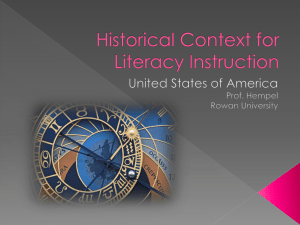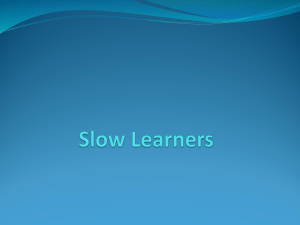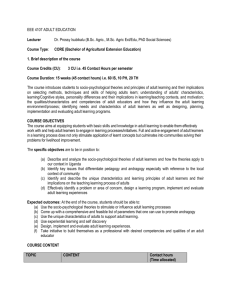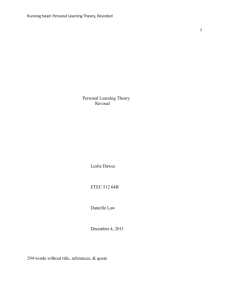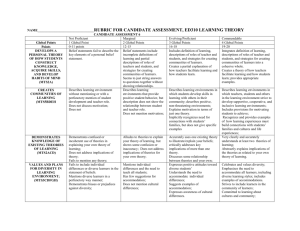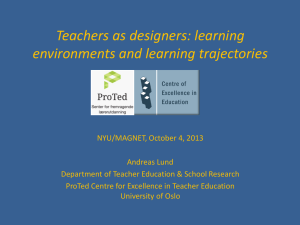- DepEd Region 7
advertisement
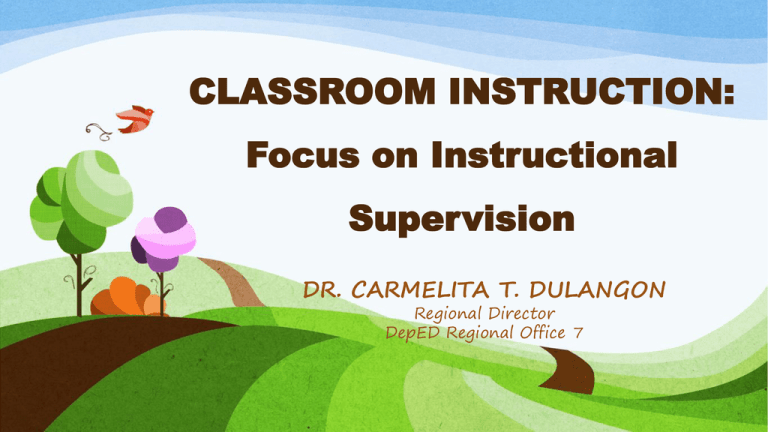
CLASSROOM INSTRUCTION: Focus on Instructional Supervision DR. CARMELITA T. DULANGON Regional Director DepED Regional Office 7 By reading the plan, do you know . . . 1. What the teacher will do to prepare the learners? 2. How will the teacher present the new lesson? 3. How will the teacher enable the learners to put their learning into actual practice? 4. How will the teacher assess the learning of the pupils/students? 5. What assignment will the teacher give to reinforce, enhance, enrich or expand the newly learned knowledge/skills/attitude?/or to prepare the learner for the new lesson? DISCUSSION: - Before you can do instructional supervision, particularly on classroom instruction, you must first take a look at the actual teaching-learning process. This starts from looking at the Lesson Plan and then the actual observation of an actual class. Challenge: • Do you know what to look for in a Lesson Plan that will tell you that the plan will truly carry out the intended lesson? • Do you know what to look at during the actual teachinglearning activity? • Do you know what assistance you can give to the teacher to improve/expand and enhance/enrich his/her teaching? Teaching is a process of organizing, directing, and integrating the elements of learning. Approach • theories of teaching and learning Method • what to teach and how to teach based upon approach/steps in teaching Strategy •classroom procedure Techniques •tips/little tricks to aid learning Approach deals with Theories 1. Behaviorist theory - “behavior” Learning is a process of conditioning. It calls for conditioned responses. (Imitation Method/Drill Method) Approach deals with Theories 2. Connectivist theory – “connect” Learning is a process of connecting Stimulus and Response (S&R). It connects particular to general, easy to difficult, simple to complex. (Inductive Method/Developmental Method) Approach deals with Theories 3. Gestalt theory - “whole is greater than the sum of its parts” Learning activities are unified and integrated around a core or central theme. (Deductive Method, Unit Method, Integration Method, Morrisonian Method) Learning is experiencing, doing reacting, understanding. Approach deals with Theories 4. Progressivist theory - “progressive” Learning aims for the total growth of the learner. It stresses activity, freedom and informality in the classroom. It calls for active doing, thinking and feeling. (Activity Approach, Experience – centered Approach, Life-centered Approach, Process Approach, Project Method, Discovery Method, Problem-Solving Method) TEACHING METHOD BASED ON APPROACH AND STEPS IN TEACHING A. Behavioral-based: 1. Imitation Method/Drill Method 2. Phonetic Method 3. Demonstration Method 4. Global Method TEACHING METHOD BASED ON APPROACH AND STEPS IN TEACHING B. Connectionist-based: 1. Imitation Method 2. Developmental Method 3. Inductive Method/Herbartian Method TEACHING METHOD BASED ON APPROACH AND STEPS IN TEACHING C. Gestalt-based: 1. Integration Method 2. Unit Method 3. Morrisonian Method 4. Deductive Method TEACHING METHOD BASED ON APPROACH AND STEPS IN TEACHING D. Progressivist-based: 1. Project Method 2. Discovery Method/ Problem-solving Method 3. Process Approach Generally, there are some common elements in a plan for teaching a lesson. These are the 3P’s + 2A’s: The procedure and steps in teaching should be simple and flexible. 3P’s • Preparation • Presentation • Practice 2A’s • Assessment • Assignment These elements correspond to the 3 laws of learning: 1. Law of Readiness 2. Law of Exercise 3. Law of Effect Questions to ask when preparing a plan for teaching What is the purpose or objective of my lesson? What is my topic/subject matter? How will I teach my lesson? Matching Laws of Learning and steps in teaching 1. Law of Readiness • PREPARATION • How will I make the learners ready/How do I prepare the learners for the new lesson? • How will I connect my new lesson with the past lesson? Matching Laws of Learning and steps in teaching • PRESENTATION • How will I present the new lesson? 2. Law of Exercise • What materials will I use? • What generalization /concept /conclusion /abstraction should the learners arrive at? • What practice exercises/application activities will I give to the learners? Matching Laws of Learning and steps in teaching • PRESENTATION • How will I assess/evaluate the learners’ learning? 2. Law of Exercise • What assignment will I give to the learners? • Will it enhance/enrich/expand the knowledge/skills/attitudes learned today? Or • Will it be a preparation for the next lesson? Matching Laws of Learning and steps in teaching •How will I recognize the 3. Law of achievement of each individual learner? Whole Effect group? Whole class? 3P’s and 2A’s - Motivation /Focusing /Establishing Mindset /Setting the Mood /Quieting /Creating Interest - Building Background Experience - Activating Prior Knowledge/Apperception - Review - Drill 3P’s and 2A’s - Showing/ Demonstrating/ Engaging/ Doing /Experiencing /Exploring /Observing - Role-playing, dyads, dramatizing, brainstorming, reacting, interacting - Articulating observations, finding, conclusions, generalizations, abstraction - Giving suggestions, reactions solutions recommendations 3P’s and 2A’s - Answering practice exercise - Applying learning in other situations/actual situations/real-life situations - Expressing one’s thoughts, feelings, opinions, beliefs through artwork, songs, dances, sports - Performing musical numbers/dances 3P’s and 2A’s - Knowledge - Process/Skills - Understanding - Product/Performance - Reinforcing today’s lesson - Enriching today’s lesson - Enhancing today’s lesson - Preparing for the new lesson A. Knowledge or Content Subjects 1. Social Studies 2. Science B. Skills or Tool Subjects 1. English 2. Filipino 3. Mathematics C. Enabling Subjects 1. Literature 2. Music and Arts 3. T.L.E. 4. P.E. D.Ennobling Subjects 1. Values Education/ Character Education / GMRC 2. Health



